Top 5 Cyber Security Threats For Small Businesses – SteveOnDigital

Hello there, I’m Steve Johnston, and I run SteveOnDigital. Today, we’re diving into a topic that’s close to my heart and crucial for the livelihood of small businesses: cyber security. As someone who’s navigated the choppy waters of digital threats firsthand, I’ve seen the impact that cyber incidents can have on businesses just like mine and perhaps yours. Why Is Cyber Security Essential? For us, the owners of small businesses, cyber security isn’t just a buzzword—it’s a crucial shield. It protects everything from our customer data to our business reputation. Small businesses are increasingly targeted by cyber criminals. Unlike large enterprises, we often lack the vast resources necessary to rebound quickly from a cyber attack. Defining The Basics Why Cyber Security Matters For Small Businesses Impact On Operational Integrity And Reputation In my experience, a single cyber breach can not only disrupt operations but also severely damage a business’s reputation. We’re in an era where customers expect their data to be handled with the highest level of security. A breach can lead to a loss of trust that’s hard to rebuild. For example, after a minor incident where suspicious activity was detected on our network, we had to work double-time to reassure our clients that their information remained safe. This was a wake-up call to strengthen our defenses, an investment that has paid dividends in customer trust and business resilience. Protecting Critical And Sensitive Data For small businesses like ours, the data we hold—be it customer details, financial information, or proprietary business knowledge—is critical. This data is not just sensitive; it’s the lifeblood of our business strategy and operations. Protecting this data is not merely a technical requirement but a core business strategy. The Growing Threat Landscape For Small Businesses In the digital age, the threat landscape for small businesses like mine—and possibly yours—is not just growing; it’s evolving rapidly. Running SteveOnDigital has taught me that staying ahead of cyber threats isn’t just about keeping the lights on; it’s about protecting our future. Cyber Threats Are On The Rise It’s alarming but true: small businesses are increasingly targeted by cyber criminals. According to a recent report, small businesses make up 43% of cyber attack victims, and these incidents are on the rise. Why? Because we often lack the cybersecurity infrastructure of larger enterprises, making us softer targets. Real-World Impact Let me share a quick story. A fellow small business owner I know suffered a major ransomware attack last year. Hackers locked him out of his own systems and demanded a ransom that nearly crippled his business financially. It was a harsh reminder of how real and immediate these threats are. Evolving Methods Cyber criminals are not just sticking to old tricks; they’re innovating. Phishing scams, for instance, have evolved from poorly written emails to sophisticated schemes like Business Email Compromise (BEC), targeting companies just like ours to steal sensitive information or funds. The Importance Of Proactive Security Measures In combating cyber threats, the difference between a proactive and reactive approach can be the difference between a secure business and a disastrous breach. Proactive Vs. Reactive A reactive strategy often means scrambling after an attack has already occurred. On the other hand, a proactive approach involves preparing and strengthening your defenses before an attack happens. From my experience, the latter not only saves money in the long run but also spares you the headache of dealing with the aftermath of a security breach. Implementing Early Security Measures Investing in robust security measures early on is crucial. For instance, implementing multi-factor authentication across all user accounts in your organization can significantly reduce the risk of unauthorized access. At SteveOnDigital, we adopted multi-factor authentication early, which has thwarted several attempted breaches. Let’s talk about antivirus software and patch management—two critical components of a proactive cybersecurity strategy. Keeping your operating system and applications up to date can protect you from many known vulnerabilities that cyber criminals exploit. Moreover, installing reliable antivirus software provides an additional layer of defense, catching malicious software before it can do harm. The Benefits Are Clear The benefits of adopting a proactive cybersecurity approach are clear and powerful. It not only protects your critical and sensitive data but also preserves your business’s reputation and builds trust with your customers. When clients know that you take their data security seriously, they are more likely to remain loyal and advocate for your services. The Top Five Cyber Security Threats Facing Small Businesses As a small business owner and the guiding force behind SteveOnDigital, I’ve seen firsthand the devastating effects that cyber threats can pose. Based on my experiences and extensive research, here’s an outline of the top five cyber security threats that small businesses like ours need to be aware of. Threat Type Common Targets Potential Impact Phishing Attacks User Credentials, Sensitive Information Data breaches, financial loss Malware and Ransomware Operating Systems, Critical Data Operational disruption, ransom payments Weak Passwords User Accounts, Company Data Unauthorized access, data theft Unsecured Networks Entire Network Systems Data interception, malicious access Insider Threats Confidential Information, Sensitive Data Data leaks, sabotage Phishing Attacks What Are Phishing Attacks? Phishing attacks are attempts by cyber criminals to trick individuals into giving away sensitive information—such as passwords, company data, or banking information—through deceptive emails or messages. These attacks often disguise themselves as legitimate requests from trusted entities. Impact On Customer And Sensitive Data When phishing attacks succeed, the effects can be catastrophic. Cyber criminals can gain access to confidential information, leading to data breaches that not only threaten our financial stability but also compromise our customer’s trust. In my own journey, adopting stringent security measures was pivotal after a phishing scam nearly jeopardized our client data. Phishing Tactics Targeting Small Businesses One particularly sinister tactic is the Business Email Compromise (BEC). Here, attackers pose as company executives or partners to request money transfers or sensitive data. This method is becoming alarmingly sophisticated, often bypassing traditional security measures due to its deceptive nature. Strategies For Protection To defend against phishing:
Data Analytics For Small Businesses – A Complete Guide
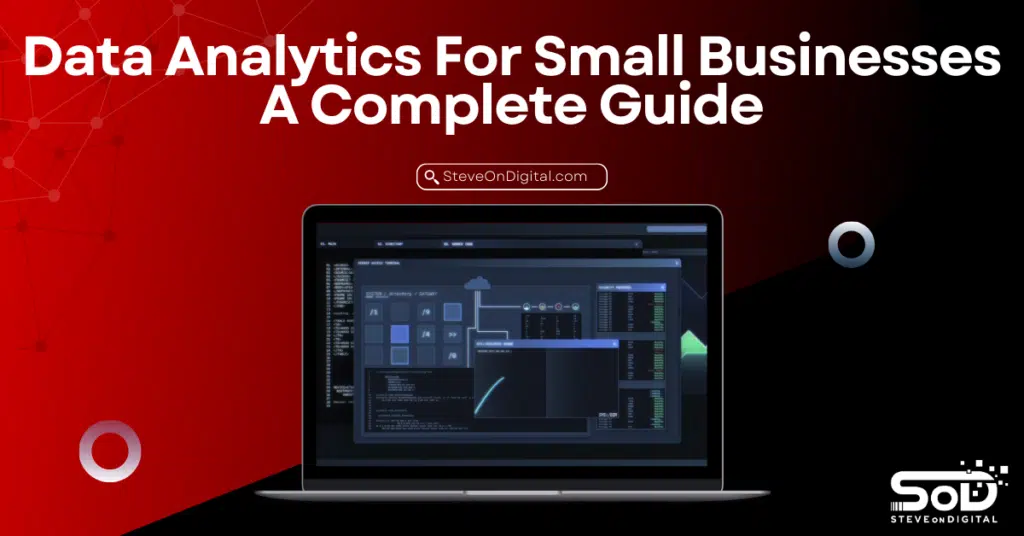
In the ever-evolving business landscape, the power of data analytics cannot be overstated, especially for small businesses. Understanding and leveraging data analytics is crucial for gaining a competitive edge and fostering substantial business growth. As someone who has navigated through various facets of digital transformation and seen its impact firsthand, I, Steve Johnston, firmly believe in the transformative power of data analytics for small enterprises. Let’s delve into how this tool can be a game changer for your business. Data Analytics In simple terms, data analytics involves examining raw data to draw conclusions and make informed decisions. For small businesses, utilizing data analytics can lead to actionable insights that drive smarter, data-driven decisions. These decisions often lead to optimizing business operations and enhancing customer satisfaction, thereby offering a distinct competitive advantage. From my experience, integrating data analytics tools into your business processes can transform mundane data into a gold mine of insights. For instance, predictive business analytics accessible through platforms like Google Analytics can forecast market trends and customer behaviors, giving small businesses a leg up in strategic planning. Driving Business Growth Through Insightful Data Analysis The use of data analytics extends beyond simple analysis; it fosters an environment where continuous improvement is possible and encouraged. I’ve seen many small business data analytics initiatives where insights garnered from sales data or customer interactions led to refined marketing strategies and improved product offerings. Imagine knowing precisely what your customers prefer or the exact time they are most likely to make a purchase—this is the power of data analysis at work. By leveraging tools and techniques of data analysis, small businesses can not only survive but thrive by adapting quickly to market changes and customer needs. Exploring The Types Of Data Available To Small Businesses Understanding the types of data you have at your disposal is the first step towards harnessing the power of analytics. Let’s break down the data types most relevant to small businesses and discuss how these can be utilized effectively. Structured vs. Unstructured vs. Historical Data Data can generally be categorized into three types: structured, unstructured, and historical. Structured data is organized and easily searchable (like data in spreadsheets), which makes it ideal for traditional data analysis techniques. Unstructured data, which includes emails, videos, and social media traffic, is less organized and requires more advanced techniques like data mining to uncover patterns and insights. Lastly, historical data refers to data collected over time that can reveal trends and help predict future occurrences when used with predictive analytics. In my role as a Digital Transformation Specialist, I have helped numerous small businesses implement systems that efficiently collect and analyze these types of data. Real Examples Of Data Sources One of the most common sources of structured data for small businesses is Customer Relationship Management (CRM) systems. These systems not only store customer information but also track interactions, sales, and marketing efforts, providing a rich source of actionable data. For example, analyzing CRM data can help in improving customer retention strategies by identifying key touchpoints that lead to enhanced customer experiences. Sales analytics, another critical data source, involves examining sales reports and performance metrics to evaluate overall sales performance and adjust tactics accordingly. Marketing communications data, such as email open rates or social media engagement metrics, can also provide valuable insights into customer preferences and behavior. These insights can then be used to tailor marketing efforts for maximum impact. Key Data Analytics Techniques For Enhancing Small Business Operations Navigating the world of data analytics can be overwhelming for small business owners, but understanding its core techniques is crucial for harnessing its full potential. Here, we’ll explore four primary types of data analysis techniques: descriptive, diagnostic, predictive, and prescriptive. Each offers unique benefits and insights that can drastically enhance business operations. Descriptive Analytics: Understanding The Present The first step in data analytics involves descriptive analytics. This technique summarizes raw data and converts it into a form that is easily understandable, helping to identify patterns and trends. For example, small businesses can use descriptive analytics through tools like Google Analytics to see social media traffic and website visitors. This helps in understanding customer behavior, providing a clear picture of what is currently happening in the business. Diagnostic Analytics: Why Things Happen Next, diagnostic analytics digs deeper—it looks at the data collected and analyzes it to determine causes and effects. For instance, if a small business notices a drop in sales, diagnostic analytics can help pinpoint exactly when and why this decline began by analyzing historical sales data and marketing efforts. This is invaluable for adjusting strategies to better align with market trends and customer preferences. Predictive Analytics: Forecasting The Future Moving forward, predictive analytics uses statistical analysis and machine learning techniques to forecast future outcomes based on historical data. For small businesses, applying predictive analytics can mean predicting customer retention successes based on past customer behavior patterns and engagement levels. Tools such as predictive business analytics accessible in advanced business software provide these insights, which are crucial for strategic planning and making informed decisions. Prescriptive Analytics: Advising On Possible Outcomes Finally, prescriptive analytics goes one step further by not only predicting the future but also suggesting actions to benefit from the predictions. This is achieved through a combination of business rules, algorithms, machine learning, and computational modeling. For example, if predictive analytics suggests an upcoming increase in demand for certain products, prescriptive analytics would recommend increasing inventory levels or adjusting pricing models to maximize profits. Practical Applications The practical application of these analytics techniques in a small business setting can lead to significant improvements in efficiency and profitability. By leveraging data analytics, small businesses can gain valuable insights into customer acquisition, enhance marketing campaigns, and optimize business operations. From my experience, implementing these techniques has led to more targeted marketing campaigns and improved customer experiences, directly impacting business growth positively. Tools And Technologies For small businesses venturing into data analytics, choosing the right tools is critical. There’s a plethora of data
The Cost Of Cybersecurity For Small Businesses – SteveOnDigital

As Steve Johnston, I’ve seen firsthand how vital cybersecurity is to the fabric of small businesses. In today’s digital age, protecting your business from cyber threats is not just a precaution; it’s a necessity. Recent statistics reveal that a significant portion of small businesses remain highly susceptible to cyberattacks. For instance, nearly half of small businesses experienced a cyberattack last year alone, underscoring the persistent risk these entities face. What Does Cybersecurity Mean For A Small Business? For small businesses, cybersecurity represents the shield that guards against potential financial ruin and loss of customer trust. This protection spans several fronts, from safeguarding sensitive customer data against breaches to ensuring business continuity in the face of security incidents. Cybersecurity isn’t just about installing antivirus software; it’s about creating a resilient environment that can withstand and quickly recover from cybersecurity incidents, emphasizing their significant impact on operations and customer trust. Common Cyber Threats Faced By Small Businesses Small businesses encounter a variety of cyber threats, with malware, phishing, and ransomware being particularly prevalent. In recent years, malware attacks have been targeted, with a notable percentage resulting in the leakage of confidential data. Phishing attacks, often delivered via email, remain a top cybersecurity concern, with a significant portion of data breaches stemming from such incidents. Implications Of Data Breaches And Cyber Attacks The consequences of cyber attacks for small businesses can be severe, impacting everything from operational capability to financial stability. Data breaches can lead to substantial direct costs, including emergency solutions and legal fines, with many incidents costing between $826 and $653,587. Furthermore, about half of small businesses report that recovery from an attack takes 24 hours or longer, significantly disrupting business operations. The True Cost Of Cybersecurity For Small Businesses I’ve guided many small businesses through the digital transformation landscape, and I’ve seen how vital cybersecurity is to their success and sustainability. Cybersecurity spending has become a critical component of a small business’s budget, reflecting the increasing investment necessary to protect against cyber threats and adapt to the evolving digital landscape. Here’s a breakdown of the costs associated with cybersecurity, along with insights into managing these expenses effectively. Outline Of Direct And Indirect Costs Associated With Cybersecurity Cybersecurity involves various direct and indirect costs that can significantly impact a small business’s budget. Type of Cost Examples Estimated Cost Range Direct Costs Legal fees, Recovery solutions $1,000 – $100,000 Indirect Costs Downtime, Lost revenue, Reputation damage $2,000 – $500,000 Common Cybersecurity Measures And Their Costs To protect against cyber threats, small businesses typically implement several cybersecurity measures. These measures, while necessary, come with their own set of costs: Cybersecurity Measure Average Cost (USD) Antivirus Software $30 – $50 per user per year Firewalls $700 – $1,000 (small business setup) Two-Factor Authentication $3 – $6 per user per month Data Encryption $500 – $2,000 (based on data volume and complexity) Cybersecurity Budget Considerations For Small Businesses Crafting a cybersecurity budget requires careful consideration. It’s not just about the cheapest options; it’s about effective, scalable solutions that offer real protection. How Cyber Attacks Impact Small Business Growth Cybersecurity is not just a technical necessity; it’s a business imperative. Here’s how cyber threats can affect your business growth and operations. Link Between Cybersecurity And Business Growth Effective cybersecurity strategies are crucial for ensuring business continuity and growth. A robust cybersecurity posture not only protects against data breaches but also safeguards the business’s reputation, ensuring customer trust and loyalty, which are essential for business growth. How Cyber Threats Hinder Business Operations And Growth Cyber incidents can disrupt business operations, leading to downtime, lost revenue, and potentially catastrophic financial strains. For example, a ransomware attack can lock a business out of its systems, halting operations completely until a ransom is paid or systems are restored. Real-Life Examples Of Businesses Impacted By Cyber Incidents Many small businesses have suffered devastating consequences due to cyber incidents. For instance, a small retail business may experience a data breach resulting in significant customer data loss. The recovery costs, coupled with fines and lost customer trust, can stifle growth for years. Analyzing Small Business Preparedness: Statistics And Trends In my experience as Steve Johnston, guiding small businesses through digital challenges, I’ve observed varying levels of cybersecurity preparedness, often hindered by fewer security protections compared to larger enterprises. This disparity in cybersecurity defenses makes smaller businesses more attractive targets for cybercriminals. Here’s what recent statistics say about how well small businesses are prepared against cyber threats. Current State Of Small Business Cybersecurity Preparedness Recent data reveals a concerning trend: a significant number of small businesses lack robust cybersecurity defenses. A study found that only about 14% of small businesses rate their ability to mitigate cyber risks, vulnerabilities, and attacks as highly effective. This is alarming, considering that small businesses are frequent targets of cyber attacks due to perceived lesser security measures. Comparison Between Small And Midsize Businesses When comparing cybersecurity preparedness, small businesses often lag behind their midsize counterparts. Midsize businesses, possibly due to higher resources and greater awareness, tend to implement more comprehensive cybersecurity measures. For example, midsize businesses are more likely to have formal cybersecurity policies in place, such as incident response plans and regular security audits, which are found in only a small percentage of small businesses. Role Of Cybersecurity In Building Resilience Against New Threats For small businesses, investing in cybersecurity is not just about protection; it’s about resilience. The digital landscape is constantly evolving, with new threats emerging regularly. Effective cybersecurity measures enable businesses to withstand and quickly recover from these threats, thereby ensuring business continuity and safeguarding sensitive data. Essential Cybersecurity Measures Every Small Business Should Implement Small business owners must recognize their critical role in safeguarding their operations against cyber threats, emphasizing the need for proactive measures to protect their businesses. To protect against cyber threats, small businesses must implement essential security measures. Here are some crucial steps: Key Security Measures Benefits Of Comprehensive Cybersecurity Measures Implementing these measures can significantly reduce the risk of
Benefits Of Digital Transformation For Small Businesses
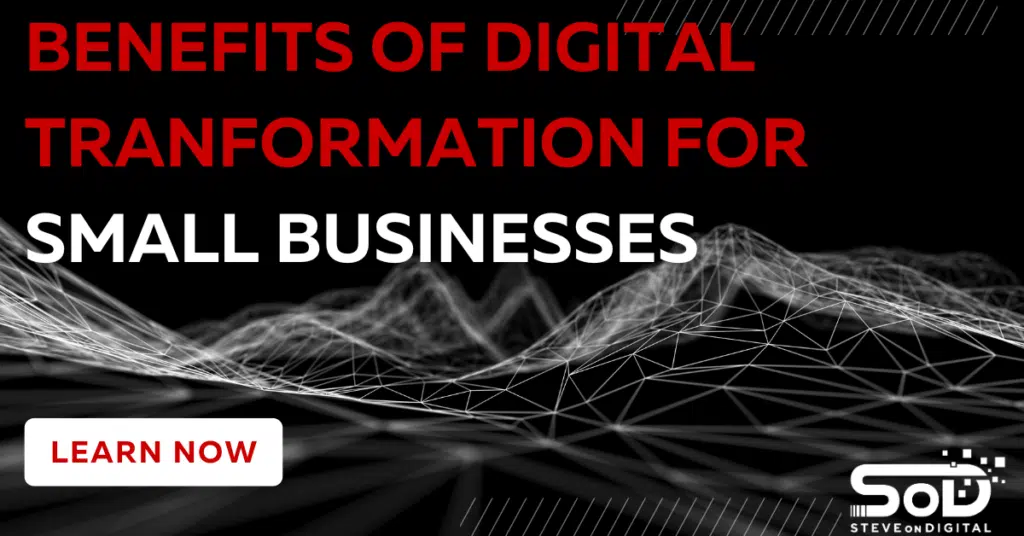
As Steve Johnston, the heart and soul behind SteveOnDigital, I’ve journeyed through the digital transformation landscape, not just as a bystander but as a participant, guiding small and medium-sized enterprises (SMEs) toward realizing their digital potential. Today, I want to shed light on a topic close to my heart: the benefits of digital transformation for small businesses. This isn’t just another buzzword; it’s a pivotal shift that can redefine the future of businesses willing to embrace change. Digital transformation is about bringing digital tech into every corner of a business. It changes the way you work and how you offer value to your customers. It’s about more than just upgrading your IT infrastructure; it’s a reimagining of business in the digital age. For small businesses, this transformation isn’t just beneficial; it’s crucial for survival and growth in today’s fast-paced, technology-driven market. By incorporating digital tools and technologies, small businesses can unlock a treasure trove of opportunities, from streamlining operations to enhancing customer experiences. But more importantly, it paves the way for sustainable growth and a competitive edge that can set your business apart. As we delve deeper, let’s explore what digital transformation really means for small businesses and how it can turn challenges into opportunities for growth. Understanding Digital Transformation What Is Digital Transformation? In the simplest terms, digital transformation for small businesses means adopting digital technologies to improve processes, enhance customer experiences, and adapt to changing market dynamics. It’s not just about having a website or using social media; it’s about leveraging technology to make every aspect of your business more efficient, agile, and customer-focused. From my experience, I’ve seen firsthand how small businesses can benefit from this shift. By integrating digital solutions, from cloud computing to customer relationship management (CRM) systems, businesses can achieve remarkable improvements in operational efficiency and customer satisfaction. It’s not just a step towards digitization; it’s a leap towards future-proofing your business. The Role Of Digital Tools And Technologies Digital tools and technologies are the building blocks of digital transformation. They range from simple applications that automate mundane tasks to sophisticated data analytics platforms that provide insights into customer behavior. For small businesses, the adoption of these tools can be a game-changer. Digital Tools: Digital Technologies: In my journey with SteveOnDigital, I’ve embraced these tools and technologies, not just as recommendations for others but as integral parts of my own business strategy. For instance, adopting a software management solution for customer data has enabled me to deliver personalized content and courses to my audience, significantly enhancing customer engagement and satisfaction. Moreover, my active use of data analytics has been instrumental in understanding the needs and behaviors of my audience. This not only informs my content strategy but also allows me to adjust my digital marketing efforts for maximum impact. The result? A stronger connection with my community and sustainable growth for SteveOnDigital. Core Benefits Of Digital Transformation Embarking on a digital transformation journey can be a game-changer for small businesses, especially those like ours at SteveOnDigital, by unlocking a myriad of digital transformation benefits. Here, I’ll dive into how this pivotal shift not only enhances operational efficiency digital transformation and customer experience but also opens up new markets and revenue streams. Digital transformation enables future digital growth, setting the stage for long-term success and innovation. Enhanced Operational Efficiency One of the most immediate benefits of digital transformation is the significant boost in operational efficiency. By integrating digital processes and cloud-based solutions, small businesses can streamline their operations, reducing the time and resources spent on manual tasks. In my experience, automating repetitive tasks such as customer inquiries and billing has freed up our team’s time to focus on strategic initiatives and innovation. It’s not just about doing things faster; it’s about doing them smarter, allowing us to deliver more value to our clients in less time. Improved Customer Experience The heart of digital transformation lies in its ability to enhance how we connect with and serve our customers. By harnessing the power of data analytics to analyze customer data, small businesses can gain invaluable insights into customer behaviors and preferences, enabling them to deliver more personalized, high-quality user experiences. At SteveOnDigital, leveraging customer data has enabled us to tailor our digital content and offerings to better meet the needs of our audience. By understanding what our users find valuable, we’ve been able to enhance user satisfaction significantly, turning casual visitors into loyal followers. Access To New Markets And Revenue Streams Digital transformation doesn’t just improve what we’re already doing; it opens up entirely new opportunities for growth and expansion. Through digital platforms and marketing strategies, small businesses can reach new audiences and explore innovative business models. Incorporating AI into our digital strategy at SteveOnDigital has been transformative. By automating customer segmentation and personalizing content recommendations, we’ve been able to engage with our audience more effectively, leading to higher conversion rates and uncovering new revenue opportunities. Comparison Of Pre And Post-Digital Transformation Aspect Pre-Digital Transformation Post-Digital Transformation Operational Efficiency Manual tasks dominate, leading to higher time and resource consumption. Automation of repetitive tasks reduces time and resources spent. Customer Experience Limited personalization leading to generic customer interactions. Enhanced personalization through data analytics improves satisfaction. Market Access Primarily local, with limited outreach. Global reach through digital platforms and marketing strategies. Digital Transformation Strategies For Small Businesses As we venture deeper into the digital era, it becomes clear that having a robust strategy is pivotal for small businesses aiming to reap the benefits of digital transformation. It’s crucial for business leaders to understand the importance of guiding their organizations through this shift, emphasizing a software-centric approach for optimal return on investment and realizing the benefits of digital transformation in terms of cost optimization, increased productivity, and improved customer experience. Drawing from my journey with SteveOnDigital, I’ve identified essential components that form the backbone of a successful digital transformation strategy. Key Components Of A Successful Digital Transformation Strategy Incorporating these elements into your digital transformation strategy not only
What Is Cloud Computing For SMEs – Complete Guide
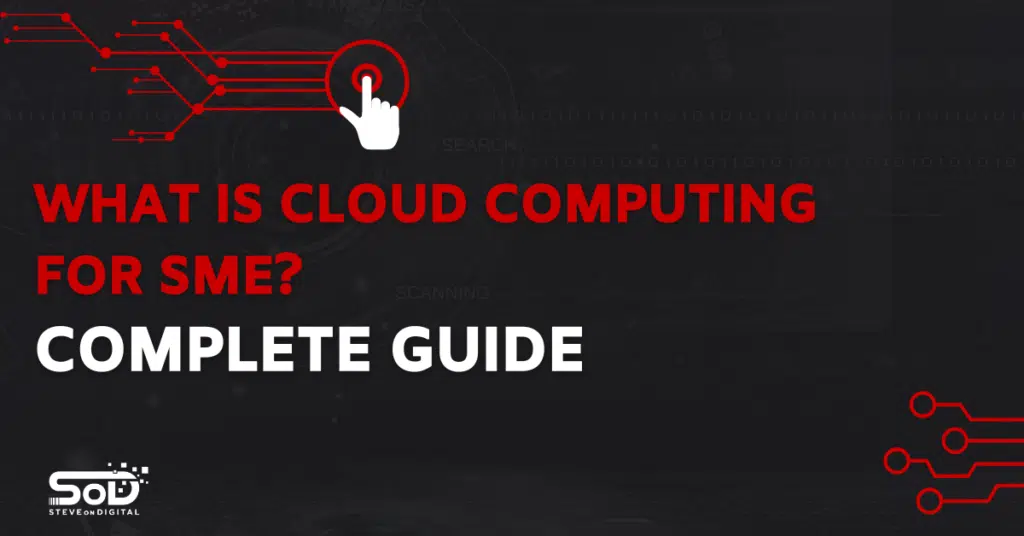
Hello, fellow small business owners, I’m Steve Johnston from SteveOnDigital. Today, I’m here to share some insights into how cloud computing is not just a buzzword but a revolutionary tool that’s reshaping how we conduct our businesses in the digital era. With my background in electrical engineering, an MBA, and a master’s in Project Management, I’ve navigated through the tech landscape to bring you practical advice that cuts through the jargon. The digital era brings both opportunities and challenges. On one hand, we have access to a plethora of tools and technologies that can propel our businesses to new heights. On the other hand, the sheer volume of options and the rapid pace of change can be overwhelming. This is where cloud computing shines as a beacon of efficiency and scalability. From my experience, incorporating cloud computing into your small business isn’t just about staying up-to-date with the latest tech trends; it’s about leveraging a powerful tool that can significantly streamline your business processes, enhance your data security, and offer unparalleled flexibility and scalability. Let’s demystify cloud computing together and explore how it can be a game-changer for your business. The Essentials Of Cloud Computing Cloud computing is all about getting computer services like servers, storage, databases, and software over the internet, which we call “the cloud“. It’s a way to use cool tech stuff quickly, with the flexibility to scale up or down as needed, and it can save money, too. This means you typically pay only for the cloud services you use, helping lower your operating costs, run your infrastructure more efficiently, and scale as your business needs change. Simple Definition And Explanation To break it down further, cloud computing can be categorized into three main types of services: Key Components The Shift From Traditional IT To Cloud-Based Solutions The transition from traditional IT to cloud-based solutions marks a significant shift in how businesses operate. Traditional IT systems often require a significant upfront investment in physical hardware and ongoing maintenance to manage and update this hardware. In contrast, cloud computing services eliminate the need for this, as the cloud provider manages the infrastructure. Strategic Advantages Of Cloud Computing For SMEs In the journey of transforming SteveOnDigital into a hub for small and medium-sized enterprises (SMEs) looking to navigate the digital landscape, I’ve seen firsthand the transformative power of cloud computing. Let me share some strategic advantages that cloud computing brings to the table for SMEs. Cost-Effectiveness One of the most compelling reasons for SMEs to embrace cloud computing is its cost-effectiveness. Traditional IT infrastructure demands a significant upfront investment in hardware and software, alongside ongoing expenses for maintenance and upgrades. Cloud computing, however, operates on a pay-as-you-go model, significantly reducing the financial burden on small businesses. This model allows you to only pay for the computing resources you use, which can dramatically lower operating costs. Scalability Scalability is a critical feature for growing businesses. Cloud computing offers the flexibility to scale your computing resources up or down based on your current needs. This elasticity means that during peak seasons or unexpected surges in demand, you can easily increase your resources without the need for physical hardware upgrades. Collaboration Cloud computing has revolutionized how teams collaborate, especially in today’s remote work environment. Cloud-based tools and platforms enable seamless communication and collaboration among team members, no matter where they are located. Real-time data sharing and updates ensure that everyone is on the same page, enhancing team productivity and efficiency. Security And Business Continuity Data security and business continuity are paramount for SMEs. Cloud companies spend a lot of money to keep your data safe. They use strong security to protect against hackers and to prevent your information from getting lost. Moreover, cloud computing ensures business continuity with robust backup and disaster recovery solutions, safeguarding your business against catastrophic data loss. Mobility The mobility that cloud computing offers is unparalleled. Whether you’re working from home, meeting clients, or on the move, cloud services ensure that you have access to your business operations anywhere there’s an internet connection. This level of accessibility not only boosts productivity but also provides the flexibility that modern businesses need to thrive. Comprehensive Cloud Solutions For Streamlining SMEs Cloud computing isn’t a one-size-fits-all solution; it’s a vast ecosystem of services that cater to various business needs. From customer relationship management (CRM) to accounting and project management, cloud services offer SMEs the tools they need to streamline their operations. Let’s delve into how these solutions can transform your business. Exploration Of Cloud Services For Critical Business Functions Real-World Applications Implementing cloud solutions leads to automation of routine tasks, freeing up valuable time for strategic planning and growth initiatives. Collaboration tools like video conferencing and shared documents enhance teamwork, while remote work solutions ensure that your business remains resilient in the face of challenges. Case Studies: SMEs Benefiting From Cloud Adoption I’ve worked with numerous SMEs on their digital transformation journeys, and the success stories are truly inspiring. For instance, a local retail store adopted cloud-based inventory management and saw a 20% reduction in stock discrepancies. Another example is a marketing agency that switched to a cloud-based project management tool, resulting in a 30% increase in project delivery efficiency. These are just a few examples of how cloud computing can empower your small business, making operations more efficient, enhancing security, and providing the scalability needed to grow. As we continue to explore the vast potential of cloud computing, remember that the journey is unique for each business, and finding the right mix of cloud services is key to unlocking your business’s full potential. Selecting And Navigating Cloud Services As we delve deeper into the realm of cloud computing, it’s crucial to understand that selecting the right cloud services and providers is not a one-size-fits-all scenario. Each small business has its unique needs, goals, and challenges. As Steve Johnston, the person behind SteveOnDigital, I’ve navigated through these decisions firsthand and want to share some insights to help you make
Benefits Of Cloud Computing For Small Businesses

Hello, fellow entrepreneurs and small business owners! I’m Steve Johnston, your guide through the ever-evolving landscape of digital transformation. My journey has been enriched by a deep commitment to family, sports, and continuous learning—values that resonate deeply with the entrepreneurial spirit. Digital Transformation Imperative In our journey toward digital excellence, we’re at a pivotal moment where adapting to digital technologies is no longer optional but a necessity for sustained growth and competitiveness. For small businesses, the digital era presents an unparalleled opportunity to scale and innovate in ways previously unimaginable. The imperative to embark on this digital transformation journey stems from the need to remain agile in a business environment where change is the only constant. Limitations Of Traditional IT Many of us started our entrepreneurial journeys relying on traditional IT infrastructures. Yet, the costs and challenges of maintaining these on-premises systems have become increasingly apparent. From the hefty investments in hardware to the complexities of software licenses and updates, the traditional IT setup is both capital and labor-intensive. This model not only strains our budgets but also diverts valuable resources away from innovation and growth initiatives. Cloud Computing: A Paradigm Shift Enter cloud computing—a paradigm shift offering a beacon of hope for small businesses seeking to overcome these hurdles. Cloud computing has revolutionized the way we access and manage computing resources. By leveraging cloud technology, businesses can scale services to fit their needs, customize applications, and access cloud services from anywhere with an internet connection. Comparison Of Traditional IT vs. Cloud Computing Feature Traditional IT Cloud Computing Initial Costs High upfront investment in hardware and software Minimal upfront costs, pay-as-you-go model Scalability Limited by physical infrastructure Easily scalable to meet business needs Maintenance Requires in-house team for updates and repairs Maintained by the cloud provider Accessibility Accessible only within the office network Access from anywhere with an internet connection Security Dependent on in-house measures Robust security measures by cloud providers Innovation Slow due to resource constraints Fast, leveraging the latest technology This introduction to cloud computing is not just about the benefits of cloud computing for small businesses; it’s about recognizing a transformative solution that offers scalability, significant cost savings, and unprecedented opportunities for innovation. Financial Liberation Through Cloud Computing Eliminating Upfront Investment One of the most compelling benefits of cloud computing for small businesses is its ability to eliminate the need for costly upfront investments in hardware and software licenses. As someone who has navigated the ups and downs of running a digital-centric business, I’ve witnessed firsthand how cloud services have reshaped our financial planning. Cloud computing allows us to subscribe to cloud computing services and cloud platforms, effectively turning capital expenses into operational costs. This shift not only frees up capital for other strategic investments but also aligns IT expenses with business growth. Operational Cost Optimization The cloud’s pay-as-you-go model is a game-changer for managing IT budgets. Small businesses can now access a wide range of computing services and only pay for what they use. This model offers a level of flexibility and efficiency that traditional IT infrastructures simply cannot match. By optimizing operational costs, small businesses can redirect savings towards areas that drive business value, such as customer relationship management and project management tools, enhancing our ability to streamline business processes. Maintenance And Upgrade Efficiency Another area where cloud computing shines is in its maintenance and upgrade efficiency. Traditionally, a significant portion of our IT resources—both financial and human—was devoted to server maintenance and software upgrades. By embracing cloud computing and relying on cloud providers for these tasks, we’ve been able to significantly reduce both the direct costs and the opportunity costs associated with in-house IT maintenance. Cloud computing offers not just savings but also peace of mind, as the responsibility for ensuring the latest security and performance standards now rests with expert cloud service providers. Collaboration And Operational Transformation In the heart of today’s digital transformation, small businesses find themselves at a crossroads. As the owner and author of SteveOnDigital, I’ve navigated these changes firsthand, especially the shift towards more flexible, collaborative work environments enabled by cloud computing. Let’s dive into how these technologies are reshaping the way small businesses operate. Remote Work Enablement The rise of remote work has not just been a trend but a necessity for many, including us in the small business sector. Cloud computing has been instrumental in this shift, offering the flexibility needed for a healthy work-life balance. Through cloud technology, employees can access data, tools, and systems from anywhere with an internet connection. This capability has proven invaluable for maintaining business continuity, especially in challenging times. My own team’s experience is a testament to how cloud services have allowed us to remain productive and connected, regardless of physical location. Fostering Real-Time Collaboration Dynamic teamwork and communication have never been more critical than in today’s fast-paced business environment. Cloud applications and services enable real-time collaboration, allowing team members to work on the same digital file, share insights, and make decisions swiftly. Tools such as Google Workspace and Microsoft Office in the cloud have transformed how we approach projects, enabling enhanced collaboration that cuts across geographical boundaries. This has not only streamlined our business processes but also fostered a culture of innovation and agility. Creating A Centralized Data Ecosystem One of the numerous benefits of cloud technology is the ability to create a centralized location for data storage. This unified approach ensures accuracy and efficiency, crucial for decision-making and operational integrity. Gone are the days of manual data entry and siloed information. Now, data from various sources can be integrated and accessed in real-time, providing a comprehensive view of business operations. This has been a game-changer for us, eliminating data discrepancies and enhancing our ability to respond to market changes promptly. Scalability And Adaptability For Growth The journey of a small business is one of constant evolution, facing new challenges and seizing opportunities for growth. Cloud computing not only supports this journey but accelerates it, offering scalability and adaptability
Big Data For Small Business – Everything You Need To Know
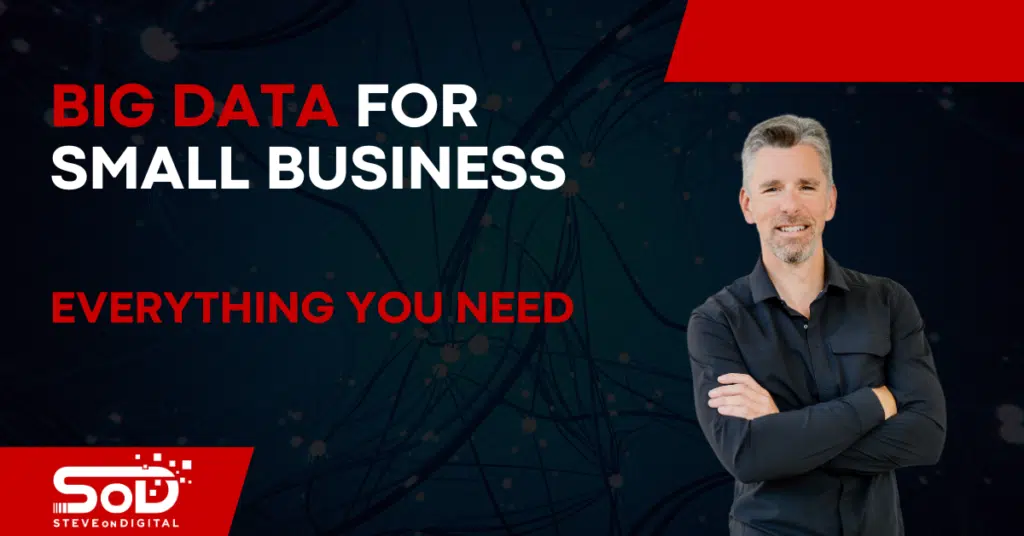
As a digital transformation specialist with a deep background in project management and a passion for empowering small and midsize businesses (SMBs), I’ve witnessed firsthand the transformative power of big data. In today’s digital age, leveraging big data can provide invaluable data and meaningful insights that fundamentally change how small businesses operate and compete. What Is Big Data? Big data refers to extremely large data sets that may be analyzed computationally to reveal patterns, trends, and associations, especially relating to human behavior and interactions. Three key characteristics define big data: volume, variety, and velocity. Importance Of Big Data Analytics In the digital age, big data analytics has become crucial for small and midsize businesses to gain insights and drive business decisions. Using analytics tools like Google Analytics or advanced Customer Relationship Management (CRM) systems, businesses can parse through vast amounts of data to extract valuable information that informs strategic decisions. This ability to make data-driven insights enhances competitiveness and efficiency, providing a significant edge over those relying on manual methods. Decoding Big Data Big Data Vs. Small Data For most businesses, especially small and midsize businesses, the challenge lies in moving from data collection to extracting actionable insights. Big data provides a comprehensive view, while small data helps in quick decision making. Understanding Data Types Getting Started With Big Data In Small Businesses Identifying Key Data Needs Every small business should start its big data journey by identifying key data needs. Customer data (from CRM systems or customer feedback), sales data (from point-of-sale systems or e-commerce analytics), and financial data (from accounting software) are foundational for informed decisions. Tools And Technologies For Data Analytics For small businesses, the array of available analytics tools can be daunting. However, starting with accessible platforms like Google Analytics is advisable, which provides insights into online customer behavior and marketing effectiveness. As needs grow, more sophisticated analytics solutions from specialized analytics companies can be incorporated to delve deeper into big data for small business, offering more granified marketing analytics and predictive business analytics accessible to small and midsize businesses. Driving Decisions Through Data As the owner of SteveOnDigital (and other businesses) and an advocate for digital transformation in small and midsize businesses, I’ve seen how big data can be a game changer. Let’s delve into how businesses can transform raw data into actionable insights and make swift, informed decisions. Transforming Data Into Actionable Insights And Informed Decisions Data analysis is not just about gathering information; it’s about turning that information into actionable insights that can drive strategic business decisions. Here’s how I apply this in my operations and how you can too: Real-Time Insights In the fast-paced digital age, the ability to make quick decisions is crucial. Big data enables real-time insights, allowing businesses to react instantly to market changes and customer needs. Customer Insights And Engagement Engaging effectively with customers and securing their loyalty involves understanding and anticipating their needs. Here’s how big data plays a crucial role in enhancing customer retention and personalizing marketing messages. Analyzing Customer Behavior And Preferences Through Data By deeply analyzing the data collected from various touchpoints, businesses can gain a thorough understanding of their customers: Enhancing Customer Retention And Personalizing Marketing Messages With Predictive Analytics Predictive analytics not only helps in understanding what the customer wants today but also predicts future trends, enabling personalized marketing that resonates more effectively with the audience. Optimizing Operations And Efficiency With Big Data Big data is instrumental in optimizing business operations, making them more efficient and responsive to market demands. Streamlining Operations Effective data use can streamline operations significantly: Identifying Hidden Patterns And Gaining Insights To Improve Efficiency One of the most valuable aspects of big data is its ability to reveal hidden patterns that are not apparent to human analysts. Financial Management As the owner of SteveOnDigital, I’ve always emphasized the power of data in transforming various aspects of business, and financial management is no exception. Here’s how small and midsize businesses can harness big data for smarter financial planning. Leveraging Financial Data For Accurate Budgeting And Forecasting Accurate budgeting and forecasting are crucial for the health of any business, especially small businesses where resources are limited. Here’s how leveraging financial data helps: Predictive Business Analytics Predictive business analytics accessible to small businesses play a crucial role in financial planning: Empowering Your Workforce Data-driven approaches are transforming human resources, from recruitment to employee satisfaction, proving that big data is not just about customer insights but also about enhancing workforce productivity. Enhancing Recruitment And Performance With Data-Driven Insights The recruitment process can be significantly improved with big data analytics: Leveraging Human Resources Data To Boost Employee Satisfaction And Productivity Employee satisfaction is key to productivity, and here’s how big data helps: Marketing With Precision Marketing strategies backed by big data lead to more precision in targeting and higher efficiency in results. Here’s how I apply these strategies in my business. Developing Targeted Marketing Strategies Using Customer And Market Data Targeted marketing strategies are essential for maximizing engagement and conversions: Measuring And Optimizing Marketing ROI With Data Analytics The ultimate goal of any marketing campaign is to achieve a high return on investment (ROI), and data analytics is critical in measuring and optimizing these efforts: Security And Privacy As a business owner at SteveOnDigital, I know too well that managing sensitive business and customer information with utmost security is crucial. Here’s what small businesses should focus on to safeguard their data effectively. Best Practices For Data Security In Handling Sensitive Business And Customer Information Effective data security is foundational for any business, especially when handling sensitive information. Here are some best practices: Compliance And Privacy Laws Navigating compliance and privacy laws is a critical aspect of managing business data: Building A Sustainable Big Data Strategy Developing a sustainable big data strategy is key to long-term success. Here’s a guide to creating a strategy that aligns with your business goals. Step-By-Step Guide To Developing A Big Data Strategy For Long-Term Success A strategic
What Data Should A Small Business Collect? – A Complete Guide
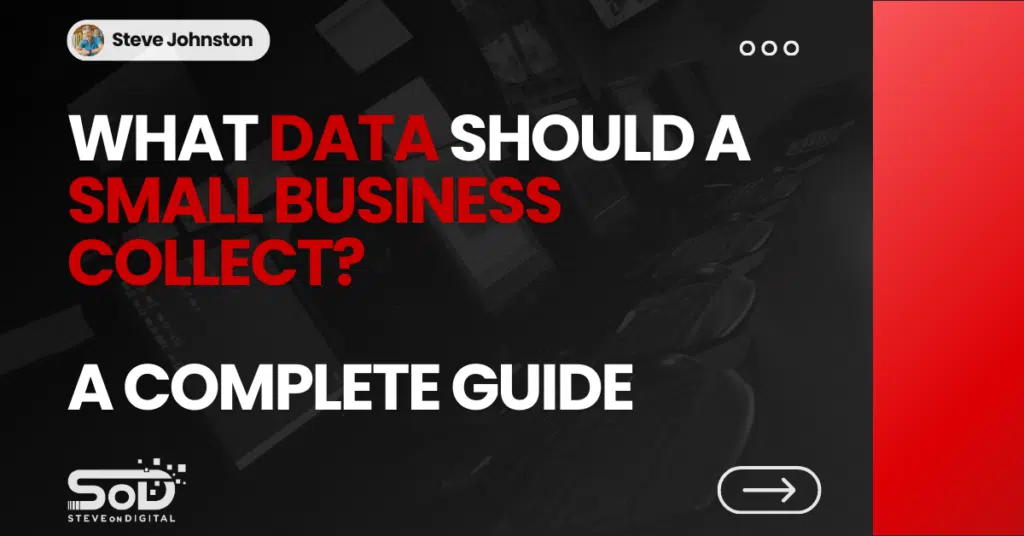
In my role as a Digital Transformation Specialist, I’ve seen firsthand how crucial data is in understanding market trends and customer behaviors. Data isn’t just numbers; it’s the cornerstone of smart business decisions. By analyzing customer data, small businesses can uncover patterns that inform product development, marketing strategies, and even operational changes. For example, by tracking which products customers spend the most time viewing on your website, you can prioritize stocking those items or promoting them more heavily. But it’s not just about having access to data. It’s about having the right data. In the digital era, where every interaction can be tracked and measured, small businesses can quickly become overwhelmed with the amount of information available. That’s why it’s essential to focus on business decisions that are informed by relevant data points. This approach ensures that you’re not just collecting data, but using it to make informed decisions that directly impact your business’s growth and efficiency. Navigating Challenges In Data Collection Collecting the right data can be a daunting task, especially for small businesses that may not have dedicated data teams. The challenge often lies in knowing which data to collect and which tools to use. For instance, small businesses need to avoid the pitfall of collecting all available data without discerning its relevance. This can lead to costly mistakes, such as investing in marketing strategies that do not align with customer needs or business objectives. Choosing the correct data type to collect is crucial. For my own businesses, SteveOnDigital, StemJee and MindfulTech Institute, I focus on collecting qualitative and quantitative data that directly relates to our operational needs and customer engagement metrics. This selective approach helps prevent the overload that comes from trying to analyze irrelevant data, allowing us to focus on information that genuinely contributes to strategic decision-making. Data collection methods also need to be carefully considered to ensure accuracy and relevance. Secondary data collection, for instance, can be a cost-effective way to gather insights without conducting primary research. However, it’s important to validate the sources and relevance of this data to your specific business context to avoid basing decisions on outdated or incorrect information. Comprehensive Guide To Essential Data Types Customer Acquisition Data Understanding how customers find your business is crucial for optimizing marketing efforts and increasing visibility. In my experience, using online surveys and market research has proven effective in identifying the main channels through which potential customers discover our services. Additionally, tools like Google Analytics offer invaluable insights into customer demographics and behavior, allowing businesses to tailor their marketing strategies more effectively. For instance, by analyzing data collected through Google Analytics, we can see which marketing channels are driving the most traffic to our website and adjust our budget to focus more on those channels. This targeted approach not only saves time but also enhances the effectiveness of our marketing efforts. Customer Engagement Data Once customers find your business, engaging them effectively is key to building lasting relationships. Tracking interactions through your website or physical store can provide critical insights into customer preferences and behavior. Social media analysis and customer feedback are also invaluable data sources for understanding how customers interact with your brand. For example, we regularly analyze feedback collected from social media and other platforms to understand our customers’ communication preferences. This information helps us tailor our outreach and engagement strategies, ensuring that we meet our customers’ expectations and enhance their overall experience with our brand. Customer Retention Data Retaining customers is often more cost-effective than acquiring new ones. Understanding why customers leave—or why they stay—can provide essential insights for improving service and product offerings. Direct feedback and studies on customer purchase history and lifetime value are particularly useful for this purpose. Effective Data Collection Methods Primary Data Collection Techniques In my experience running SteveOnDigital, directly engaging with customers has always been a cornerstone of how we understand their needs and preferences. Here are a few methods we’ve found particularly effective: Secondary Data Collection Practices While primary research is invaluable, secondary data collection also plays a critical role in our overall strategy. Here’s how we approach it: Optimizing The Mix Of Data Collection Methods Finding the right balance between different data collection methods can significantly enhance the effectiveness of our strategies. Here are some ways we achieve this balance: Data Analysis For Strategic Insights Analyzing And Reporting Data Once data is collected, the next step is turning it into actionable insights: Data Security And Ethical Considerations Data security and ethical data management are paramount for maintaining customer trust and complying with legal standards: Leveraging Data To Propel Business Growth Enhancing Customer Experience In my years steering SteveOnDigital, I’ve learned that enhancing the customer experience is key to sustained business success. Here’s how I use data to make that happen: Feedback Theme Common Customer Comments Actions Taken Product Quality “Wish the product durability was better.” Improved material quality in the next batch. Website Usability “Had difficulty navigating the checkout page.” Redesigned user interface to simplify checkout. Customer Service Response “Support was slow to respond.” Implemented a faster, tiered response system. Optimizing Marketing And Sales Efforts Data not only helps in understanding customers but also in refining our marketing and sales strategies to be more effective: Marketing Channel Customer Reach (Monthly Views) Conversion Rate (%) Budget Allocation (%) Social Media 45,000 3.2 25 Email Marketing 30,000 5.1 30 PPC (Pay-Per-Click) 20,000 2.5 20 SEO (Organic Search) 50,000 4.0 25 Strategic Business Decision-Making Data is at the heart of all our strategic decisions, from product development to market expansion: Decision Type Data Utilized Outcome Product Line Expansion Customer purchase history & preferences Launched a new line of eco-friendly products. Inventory Management Sales trend analysis Reduced excess stock by 15%, minimizing waste. Market Entry Consumer demographic and interest data Entered the Asian market, growing sales by 20%. Conclusion Adopting a data-driven culture has been crucial for the growth and resilience of SteveOnDigital: In conclusion, integrating a robust data-driven approach into every layer of your business
What Does A Data Analyst Do In A Small Company? – SteveOnDigital
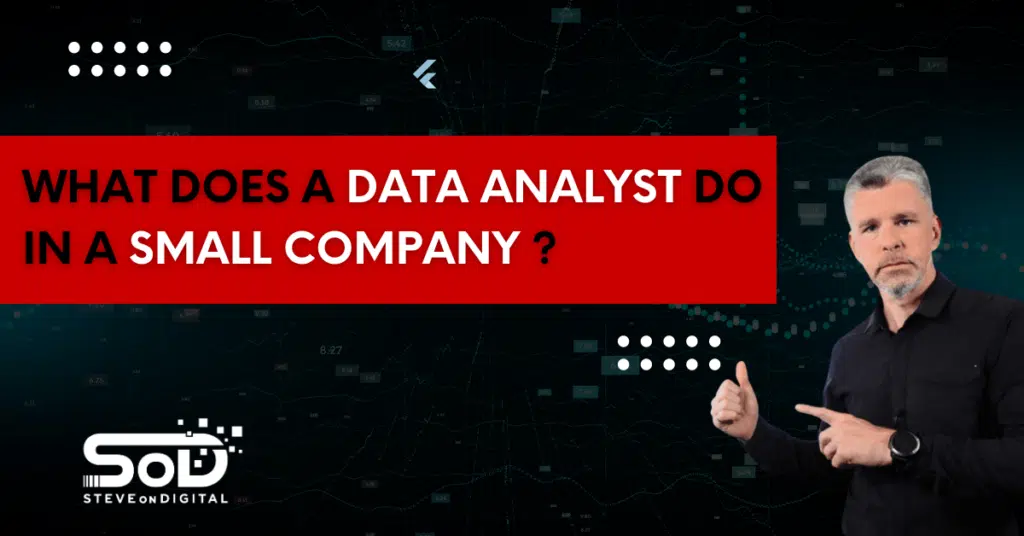
Data analysis involves evaluating data sets to extract actionable insights that can inform business decisions. In small companies, data analysis can be crucial, even with limited resources. These companies may not have vast amounts of data compared to larger firms, but every piece of data, whether it’s customer data, sales statistics, or market trends, can offer valuable insights. Effective data analysis can lead to improved customer service, product development, and overall strategic direction. Contrasting Data Roles In larger firms, data analysts often have the luxury of focusing on specific aspects of business data due to the division of labor and more abundant resources. In contrast, data analysts in small companies typically wear multiple hats. They might handle everything from data collection to implementing big data analytics strategies. The scope of their role means they often have a direct impact on business operations and decision-making. My journey mirrors this versatility. From my own experience as a Digital Transformation Specialist, I understand the unique challenges and rewards that come with managing multiple facets of business data in smaller settings. Importance Of Data For Small Businesses For small businesses, every piece of data holds significant potential. Leveraging data analytics allows small companies to make informed decisions that can lead to competitive advantage and customer satisfaction. In my experience, utilizing tools like Google Analytics has enabled us to track website traffic and user behavior, providing insights that are critical for digital strategy adjustments and enhancing customer experience. Such tools are part of the arsenal that makes data invaluable for small businesses striving for growth and efficiency. Core Responsibilities Of Data Analysts In Small Companies Gathering And Managing Data Data collection is a fundamental task for data analysts in small companies. They gather data from various sources, including customer interactions, online transactions, and market research. Once collected, organizing this data into structured data sets is crucial for effective analysis. Over time, I have developed systems to streamline data management processes, ensuring that all the data collected is accurate and readily available for analysis. This organization is critical for small businesses that rely on swift, data-driven decision making to stay competitive. Analyzing Data For Business Insights Statistical analysis allows us to identify patterns and trends from historical data and customer data. This process helps small businesses anticipate market behaviors and align their strategies accordingly. For instance, analyzing historical sales data can reveal seasonal trends, informing inventory decisions. Data visualization tools play a crucial role in making complex data sets understandable at a glance. Tools such as bar charts, line graphs, and heat maps help stakeholders grasp the significance of the data and make informed decisions quickly. In my digital strategy advisories, I often emphasize the power of visual data representation to enhance comprehension and engagement across all levels of the organization. Implementing machine learning techniques can elevate a small company’s ability to interpret data and predict future trends. Even basic predictive models can significantly impact how small businesses allocate resources and target potential market opportunities. My experience has shown that even minimal investment in machine learning can yield substantial returns in terms of precision and insight. Translating Analysis Into Business Operations Real-life case studies often highlight the practical benefits of data-driven decision making. In my work, I’ve shared numerous examples where small businesses have leveraged data to refine their marketing strategies, optimize their supply chains, and improve overall operational efficiency. Predictive and diagnostic analytics are tools that allow businesses to not just react to past events but also anticipate future challenges and opportunities. By understanding customer behavior and market conditions, small businesses can proactively adjust their strategies to meet expected demands and mitigate potential risks. My advisory role has often focused on guiding small businesses to adopt these analytics approaches, enhancing their agility and strategic foresight. This holistic approach to data analysis not only fosters a culture of evidence-based decision-making but also equips small companies with the tools to thrive in a competitive market. Responsibility Tasks Involved Data Collection and Management Gathering, cleaning, and organizing raw and structured data. Analysis and Interpretation Applying statistical analysis and machine learning to derive insights. Reporting and Decision Support Creating reports and visualizations to communicate findings for decision making. Strategic Implementation Using insights to influence business strategy and operations. Tools And Techniques In Data Analytics Overview Of Data Analytics Tools In today’s digital era, data analytics tools range from basic software that helps in simple data analysis to complex big data analysis systems designed for intricate data manipulation. As a small business owner, I’ve realized that starting with basic tools can significantly enhance our understanding of business data, allowing us to make more informed decisions. Over time, as the business grows, incorporating more sophisticated data analytics tools becomes feasible, providing deeper insights into customer data, market trends, and operational efficiencies. For instance, early on, we used simple spreadsheet tools to track and analyze customer data and sales. As we grew, the need for more robust data visualization tools and big data analytics systems became evident. These systems allow us to handle larger volumes of data and uncover more complex patterns, crucial for scaling up operations. Tool Type Examples Usage Scenario Suitability for Small Business Basic Analytics Excel, Google Sheets Data entry and simple statistical analysis High Intermediate Tools Tableau, Power BI Data visualization and intermediate analysis Moderate Advanced Systems SAS, Apache Hadoop Big data processing and advanced analytics Low to Moderate Google Analytics And Small Business Google Analytics has been a game-changer for small businesses like ours. It’s not just about understanding who visits your website but about gaining insights into how they interact with your content. This data is invaluable for improving user experience and optimizing marketing strategies. Here’s how we leverage Google Analytics: These insights from Google Analytics have helped us make data-driven decisions that significantly boost our online presence and customer engagement. Advanced Techniques The term ‘big data’ might sound daunting for small businesses, but implementing big data analytics can be highly advantageous even for us.
Cloud Computing Pros And Cons For Small Businesses
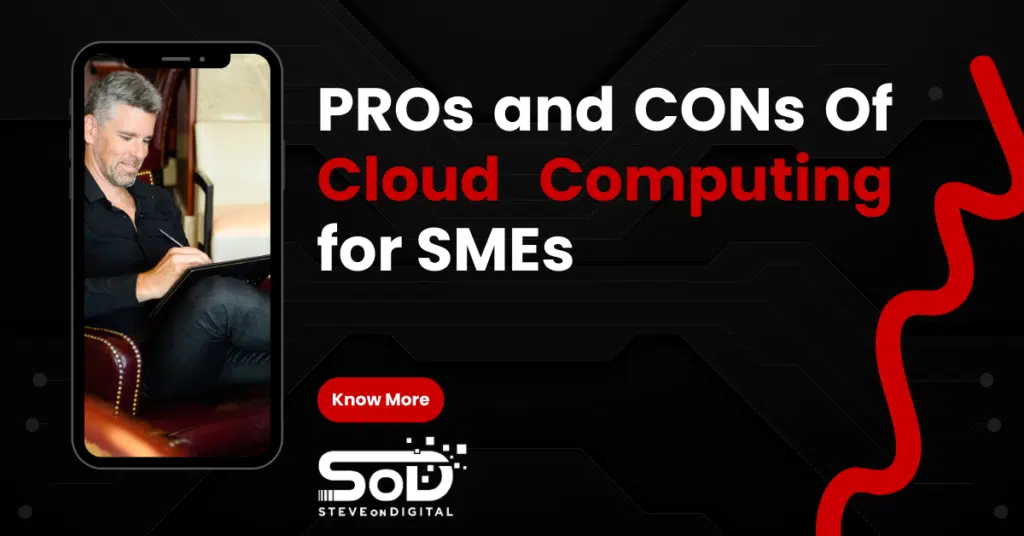
As Steve Johnston, your go-to Digital Transformation Specialist with a rich background in electrical engineering, an MBA, and a master’s in Project Management, I’ve dedicated my career to demystifying the digital landscape for small and medium-sized businesses (SMBs). Defining Cloud Computing And Its Role In Transforming The Business Landscape Cloud computing is an innovative technology that allows businesses to access data, applications, and services over the internet rather than through physical computers and servers. This shift to virtual resources has revolutionized how companies operate, offering unprecedented flexibility and scalability. Cloud computing’s essence lies in its ability to provide small businesses with the tools and capabilities that were once the exclusive domain of large corporations. The Crucial Importance Of Cloud Computing For SMBs In Today’s Digital Era For small businesses, cloud computing is not just a technological upgrade; it’s a strategic advantage. In today’s digital era, where agility and efficiency are paramount, cloud computing provides SMBs with the ability to swiftly adapt to market changes, scale operations, and improve customer experiences without the hefty investment in IT infrastructure. This democratization of technology has leveled the playing field, allowing small businesses to compete more effectively against larger competitors. The Essence Of Cloud Computing: A Business Transformation Tool Core Concepts: Accessing Remote Servers And Cloud Services At its core, cloud computing relies on the internet to provide businesses with access to data and applications stored on remote servers. This model eliminates the need for costly on-site hardware and maintenance, freeing up capital and resources that can be better spent on innovation and growth. Cloud services range from basic data storage to comprehensive computing services and sophisticated applications, all accessible via the cloud. Comparison Of Cloud Service Models Cloud Service Model Description Best for IaaS (Infrastructure as a Service) Provides virtualized computing resources over the internet. SMBs looking for full control over their infrastructure without the physical overhead. PaaS (Platform as a Service) Offers hardware and software tools over the internet, typically for application development. SMBs developing or deploying applications without investing in underlying platforms. SaaS (Software as a Service) Delivers software applications over the internet, on a subscription basis. SMBs seeking accessible, scalable applications without managing the underlying infrastructure. Transformative Business Operations: From Enhanced Data Storage To Sophisticated Applications Cloud computing has been a game-changer for business operations, offering more than just storage solutions. Cloud services now encompass advanced computing capabilities, including analytics, artificial intelligence, and machine learning, which empower small businesses to make data-driven decisions and innovate at a rapid pace. For example, as the owner and author of SteveOnDigital, I’ve leveraged cloud-based tools to optimize our content delivery, ensuring that our valuable insights and practical advice reach our target audience efficiently and effectively. Anytime, Anywhere Data Accessibility: The Power Of The Cloud One of the most significant advantages of cloud computing is the ability to access data from anywhere, at any time, as long as there’s an internet connection. This flexibility is crucial for small businesses, especially in today’s dynamic market environment. Whether I’m consulting with clients, sharing expertise on Steve’s YouTube channel, or contributing to local economic development, the cloud ensures that all the necessary information and tools are readily available, fostering collaboration and productivity regardless of physical location. Advantages Of Cloud Computing For SMBs: Transformative Benefits As someone deeply entrenched in the world of digital transformation, I’ve seen firsthand the seismic shifts cloud computing has introduced to small businesses. Let’s dive into how cloud computing reshapes the landscape for SMBs, leveraging my personal journey and insights from SteveOnDigital. Cost Management And Efficiency Eliminating Upfront Hardware Costs With Pay-As-You-Go Models One of the most significant benefits I’ve observed is the cost efficiency cloud computing brings. Traditional IT infrastructures involve hefty upfront investments in hardware and software. In contrast, cloud services operate on a pay-as-you-go basis. This model allows small businesses to avoid large initial expenses, paying only for the computing resources they use. This shift is not just about saving money; it’s about reallocating resources towards growth and innovation. Resource Scalability Based On Business Needs Scalability is another game-changer. Cloud computing allows small businesses to scale their IT resources up or down based on current needs. During a product launch or seasonal peak, for instance, a business can easily ramp up its capacity. Likewise, it can reduce resources during slower periods. This flexibility ensures that small businesses are not paying for idle resources, making operations more efficient. Embracing The Cloud: Unleashing Growth For Small Businesses In today’s rapidly evolving digital marketplace, small businesses stand to gain significantly from the strategic implementation of cloud computing. Cloud services offer a plethora of benefits tailored to enhance operational efficiency, from cost-effective data storage solutions to sophisticated cloud-based tools that facilitate seamless business operations. For small businesses, leveraging cloud computing means more than just accessing data storage or cloud backup services; it’s about unlocking the full potential of cloud services to drive innovation and competitive advantage. With a reliable internet connection and cloud service providers, businesses can enjoy enhanced cloud security, streamlined computing services, and flexible access to data—anytime, anywhere. Moreover, the adaptability of cloud computing for small businesses ensures that as your business grows, your IT infrastructure can scale accordingly without the need for significant upfront investment in local servers or data centers. By choosing the right cloud provider and engaging in a thoughtful cloud implementation process, small business owners can safeguard their customer data against data breaches while benefiting from cost-effective, pay-as-you-go pricing models. Ultimately, the strategic adoption of cloud computing not only mitigates traditional IT security concerns but also positions small businesses for sustainable growth and success in the digital age. Operational Flexibility And Scalability Adapting To Business Growth With Cloud Solutions The cloud is inherently designed to support business growth. As small businesses expand, cloud solutions can be seamlessly scaled to accommodate new demands, whether it’s adding more storage, increasing bandwidth, or integrating new services. This adaptability has been crucial for my operations at SteveOnDigital, enabling us to smoothly

